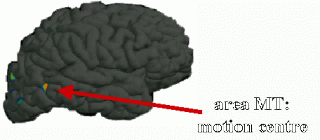Psychology Today
Post published by Art Markman Ph.D. on Jan 30, 2015 in Ulterior Motives
Your brain does some fancy calculation to give you a sense of movement.
你的大腦做了些奇特的運算以給你的運動覺。
If you spend time watching movies or TV, you have probably know that you see a moving
image on the screen, but that the sense of motion is created by your brain from a series
of static images. Typical movies, for example, flash 24 frames per second. Somehow,
the brain takes the changes from one frame to the next and gives you the illusion of fluid
movement.
如果你花時間看電影或電視,你可能已經知道,你看到的是在屏幕上移動的圖像,
但運動覺是由你的大腦從一系列的靜態圖像創建。典型的電影,例如,每秒閃爍24
How does that happen? Take a moment to try to explain it to yourself.
這是如何發生的?這一刻試圖為你自己解釋。
This question is just one of many that is explored in a great book that came out in 2015
called Flicker(link is external) by cognitive neuroscientist Jeff Zacks. The book itself
explores a variety of topics ranging from low-level aspects of the way the visual system
understands the images on the screen all the way to high-level topics like the reason why
movies are so good at creating emotion.
So, why do movies move?
這問題是2015年認知神經科學家傑夫·薩克斯出版的一本優秀的書裡眾多之一探討
所謂的閃現(鏈接外部的)。這本書本身探討各種話題,低階方面從視覺系統理解屏幕
上的圖像所有的方式到高階主題如為何電影這麼精於創造情感。
那麼,為什麼影片會移動?
You might think that what is happening is that each image persists a little on the retina
(the cells at the back of your eye that respond to light) and that changes in the image
are detected there. Or perhaps, when the image is first processed in the brain, it
recognizes small discrepancies from one frame to the next.
Neither of those possibilities is quite right.
你可能會認為正在發生的事情是,每個圖像在視網膜上仍然存在一點點(該細胞在
你的眼睛後部,為光線反映),並且在圖像中改變以檢測那裡。或者,當圖像在
大腦中首先被處理,它承認從一幀到下一個小的差異。
些臆測也可相當不正確。
The images from the screen enter the eye and hit the retina. From there, they are passed
into the brain and ultimately make their way to the occipital lobe in the back of the brain
where most visual processing is done. Initially, the brain looks for simple visual features
in the image like the presence of edges, because edges usually signal the boundaries
of objects.
的路徑到達大腦背面的枕葉在那裡大多數視覺過程處理完成。最初,大腦在圖像尋找簡
單視覺特徵如在邊緣面前,因為邊緣通常對物件的範圍發出信號。
The interesting thing is, the brain divides up the task of understanding the image in
multiple ways, with different brain areas searching for different features in the image.
The unified sense of vision we have arises because the brain ultimately puts all of those
independent properties back together.
有趣的是,大腦以多種方式劃分圖像理解任務,在不同腦區搜索圖像中不同的像貌。
我們有產生統一的視覺感,是因為大腦最終將所有那些獨立的特性重新合併一起。

Early in the processing of images a particular area of the brain called area MT
(shown in the figure) looks for blobs that have changed position. When MT sees
a blob in a location that has changed it position a bit, it gives a signal suggesting
that there was motion. Sustained activity of MT indicating motion in a particular
direction gives people the experience that an object moved. This brain area
doesn’t really care much about the blobs themselves. The blobs could actually
change shape or color from one frame to the next, it is just looking for motion.
早期大腦處理圖像的特定區域,稱為 MT 區(如圖所示),查找斑點已更改的
位置。當MT 區看到一點已改變了一些它的位置,它給了有運動的暗示信號
。 MT的持續活動偵測個特定的運動方向給人體驗對象移動的體驗。
這一大腦區域並不真正在意斑點自身。斑點從一幀到下一幀可以改變形狀或顏色,
它只是在尋找它們的動作。
So, the motion in movies comes from activity in the brain area MT. As Zacks
points out, though, this can sometimes cause problems. In particular, when a
movie is put together, it is usually constructed from a set of scenes that are spliced
(or cut) together. If the editor is not careful, when one scene is cut to the next,
some of the objects may appear to jump from one location on the screen to another.
This jarring sense of movement is called a jump cut. Filmmakers try not to create
these jump cuts, and texts on film making give suggestions for how to avoid them.
所以,在電影裡的動作來自在大腦MT區域活動。薩克斯指出,雖然,這有時會引
起問題。特別是,當電影被放映時,通常是從一組場景被剪接構造(或切斷)在
一起。如果編輯不小心,當下一個場景被切下,一些物件對象可能會從一個屏幕
位置跳轉到另一個上。
這種不和諧的運動感被稱為跳接。製片人盡量不要創建這些削減的跳躍,
並在電影製作文本裡建議如何避免這些問題。
These jump cuts are caused by the same process that causes the sense of motion
in scenes. When one scene is cut to another, if area MT detects the motion of a blob,
it will send a signal that an object in one location actually moved to another. That can
feel weird, because brain areas that calculate the size, color, and shape of the object
may not see strong similarities in the objects from one scene to the next, so you can
get a feeling of motion without have a clear sense of what moved.
這些跳接成因是由同樣的過程,在場景導致運動的感覺造成。當一個場景被切割到另
一個,如果區域的MT檢測到斑點的運動,它將發送在一個位置中的物體實際移動到
另一個的信號。因為腦區計算從一個場景到下一個對象的大小,顏色和形狀
可能看不到強烈的相似性時可感到奇怪,,這樣你就可以不具看到有明確移動物體卻
獲得運動的感覺。
One of the reasons why Flicker is an interesting read is that Zacks explores the ways
that movies exploit the structure of the brain to give us an immersive experience.
If you can pull yourself away from the screen for a few hours, it is well-worth the time
to check it out.
其中一個原因讓電影製片有興趣去閱讀的原因是Zacks開發大腦結構探索運動的模式,
使我們有身臨其境的體驗。
如果你可以讓自己脫離屏幕幾個小時,這檢查出來所花的時間很具價值。
Follow me on Twitter(link is external).
And on Facebook(link is external) and on Google+(link is external).
Check out my new book Smart Change(link is external).
And my books Smart Thinking(link is external) and Habits of Leadership(link is external)
Listen to my radio show on KUT radio in Austin Two Guys on Your Head(link is external) and follow 2GoYH on Twitter(link is external) and on Facebook(link is external).
沒有留言:
張貼留言